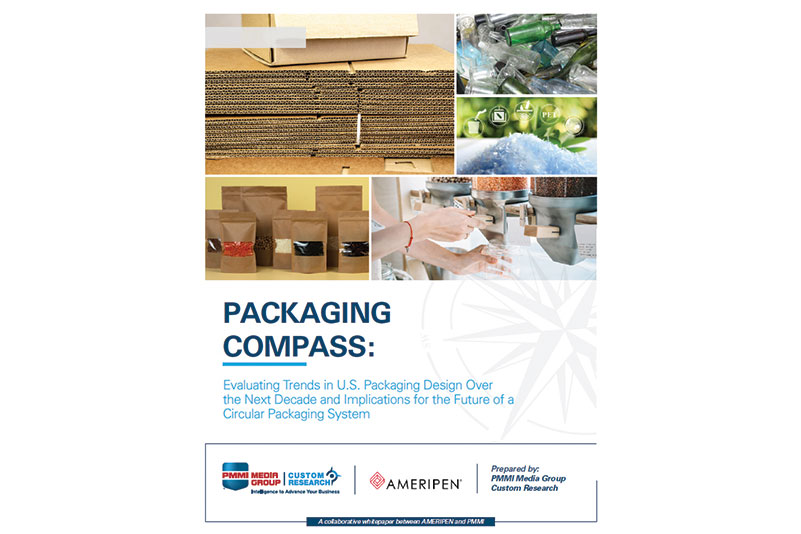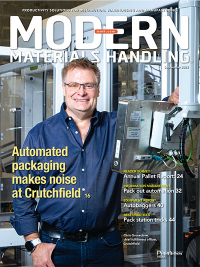Some notes from consumer packaging
A major survey from PMMI and AMERIPEN identifies some trend lines in consumer packaging that are worth considering in the world of industrial and transit packaging.
For this column, I generally reject anything focused on consumer packaging. You know, everything from PET bottles and metal beverage cans to flexible plastic wraps, films and the like.
But not this month.
This time around, let’s take a look at some data points in consumer packaging design, use and sustainability. Sometimes it’s good to peek outside your comfort zone.
Earlier this year, the packaging processing industry group PMMI and AMERIPEN, which represents the U.S. packaging value chain, published “Packaging Compass.” The report is based on a survey of 645 consumer packaged goods (CPG) brands and retailers (61% of respondents), packaging machinery OEMs (19%), as well as packaging materials suppliers and converters (20%).
They were asked about trends in consumer packaging over the next decade. Here are three that stood out to me.
1) Last year, just more than 500 billion units of packaging were produced in the United States. That number is expected to increase at a compound annual growth rate (CAGR) of 1.5% annually through 2025. However, the CAGR will actually decrease each year.
“We believe this decrease reflects the movement within omni-channel commerce to design primary packaging for shipping (ships-in-its-own-container), eliminating the need for secondary, and, in some cases, tertiary packaging.” (Read cartons and pallets.)
As a point of reference, Amazon ships about 11% of its orders in their own container (see the autobagging story in this issue). Meanwhile, 40% of Amazon’s orders are in cartons and 49% in plastic and paper flexible packaging. Makes you wonder if in the industrial/transit packaging world we will see a similar increase in ships-in-its-own-container going forward.
2) At the same time, the PMMI/AMERIPEN report expects “continued growth in plastic packaging going into 2030.”
Considering how much focus there is these days on a shift away from plastic to sustainable, reusable, recyclable materials, that trend is a bit surprising. That is until the report says that material selection is based on trying to balance a range of “competing demands on packaging to reflect challenges with distribution systems, demographics, and product and environmental protection.”
Kind of puts things in perspective. As much as some try to make the battle over sustainability and elimination of plastics from the packaging stream, that’s only part of the story.
3) Survey respondents were also asked their impression of the likelihood that the use of reusable packaging will increase in the next five years. They said: extremely likely (45%); somewhat likely (39%); neither likely nor unlikely (12%); extremely unlikely (3%); and somewhat unlikely (1%).
Clearly, the shift to reusable packaging is a mega trend. Then the report added, “we interpret this data to indicate that design for recycling is indeed a motivating factor for packaging designers… However, this specific design objective must still balance with other objectives to consider product protection, distribution, etc.”
There it is once again. Packaging is a balancing act. It serves many masters. And meeting all of those needs for any product is the primary objective whether we’re talking consumer or industrial/transit packaging.

Article Topics
AMERIPEN News & Resources
Some notes from consumer packaging Packaging industry coalition AMERIPEN elects new board membersLatest in Materials Handling
Largest Automate on record opens in Chicago on Monday May 6th April manufacturing output recedes after growing in March Carolina Handling celebrates anniversary with 58 for 58 giveaway Q1 sees a solid finish with strong U.S.-bound import growth, notes S&P Global Market Intelligence AutoStore to launch U.S. headquarters in greater Boston region Trew expanding manufacturing and development campus in southwest Ohio IFR: Robot installations by U.S. manufacturing companies up 12 percent last year More Materials HandlingAbout the Author
Subscribe to Materials Handling Magazine

Find out what the world's most innovative companies are doing to improve productivity in their plants and distribution centers.
Start your FREE subscription today.
April 2024 Modern Materials Handling

Latest Resources












